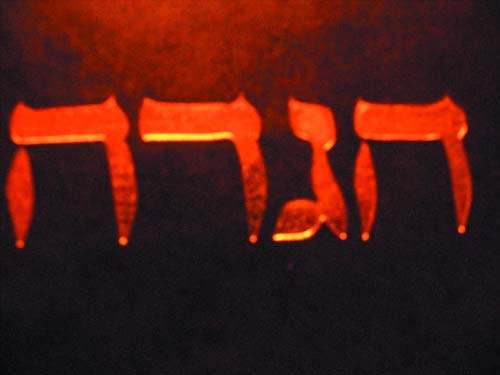













Every family has its own Pesach traditions, and every family has its haggadot of choice. Whether it’s a full set of Art Scroll for everyone, the old-fashioned/ new-fangled Maxwell House haggadah or some other edition, there are usually more than one style of haggadah available at a table, some for people to pass around and peruse, others to use when seeking out a good medrash on the text, and some that offer different interpretations that can make some people’s blood boil and provoke a good debate for a Seder. From Elie Wiesel and Shlomo Carlebach haggadot, to Lehmann, and Birnbaum, the children’s versions and the custom family-specific and dedicated versions, there is something for everyone.
The haggadot here are part of the Friedman-Sieradski collection that began more than 60 years ago. Our own haggadah is dedicated to my uncle, Yaakov Rabinowicz, a Hasidic yeshiva bochur in Warsaw. An escapee from Treblinka, he knew the Jews were doomed, but he returned to the ghetto, joined Oneg Shabbat and went from hiding place to hiding place urging the Jews to fight and die with dignity—and to take as many of the Nazis as they could with them. That revolt began on the first night of Pesach, the same night he stood on the battlements of the ghetto with a rifle in his hand and was shot to death.
My parents were both survivors. My dad, z”l, was from Munkacs, survived Auschwitz, a litany of labor camps, a death march and the liberation of Bergen-Belsen. My mother escaped from the Warsaw Ghetto and was on the Kasztner train, with a group held in Bergen-Belsen, ransomed and released in Basel in December 1944. The only time they talked about the Holocaust was on Seder night: My father would quote the hagaddah: “In each generation we should regard ourselves as if we, too, had come out of Egypt.” And then he and my mom would tell small stories, but no one talked about Yaakov, and no one knew enough to ask. I cannot find the haggadah I had as a child with pictures of the gates to Auschwitz and worse. It has disappeared from the shelf.
Fast forward to 1979, to the Zachor conference I picked up a copy of Ringelblum’s Warsaw Ghetto Diary, and found a footnote about a Yaakov Rabinowicz and references to the grave diggers of Treblinka. I called my mom and asked who that was. It was her brother. If I wanted to know more, I could find it in Hillel Siedman’s Warsaw Diary. I discovered him again when I worked with Warsaw Ghetto survivors on their memoirs. My uncle, I was told, looked like a madman, as he went from bunker to bunker, begging people to take up arms.
By Jeanette Friedman











